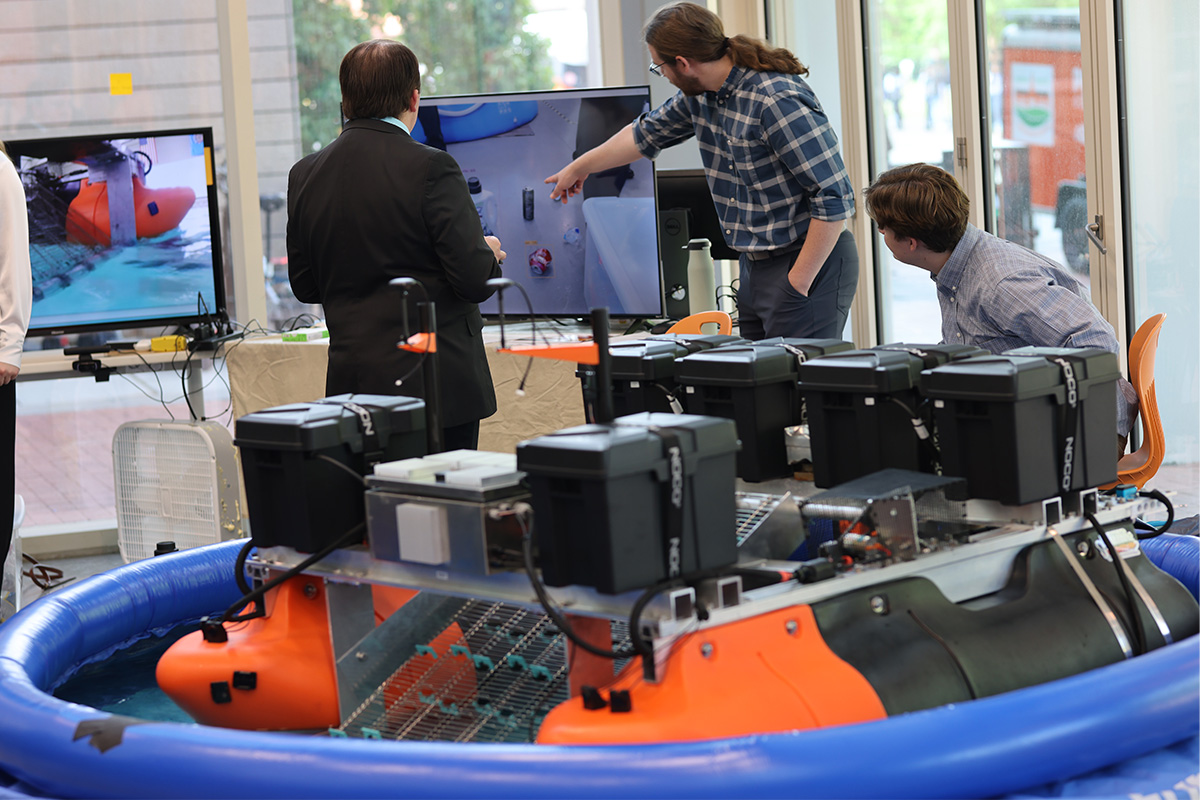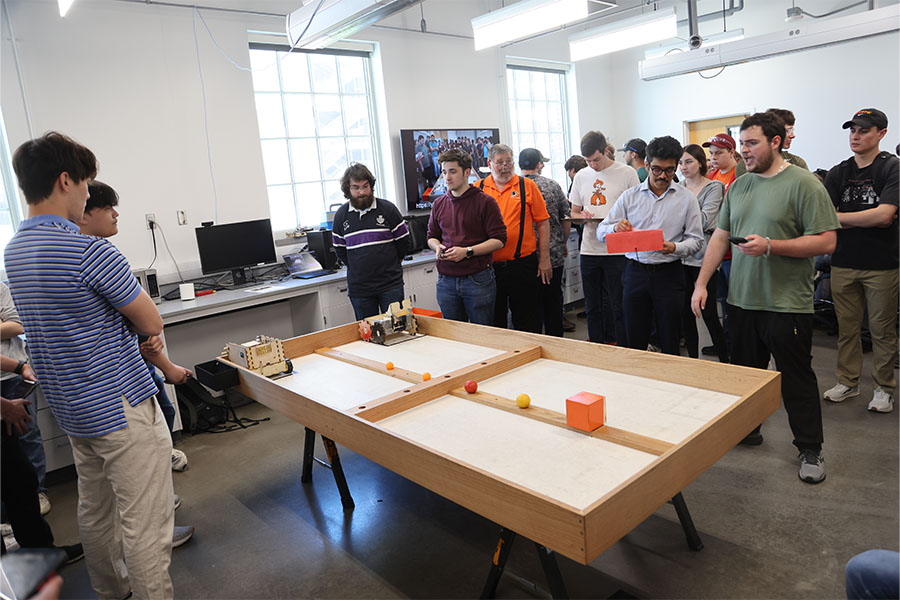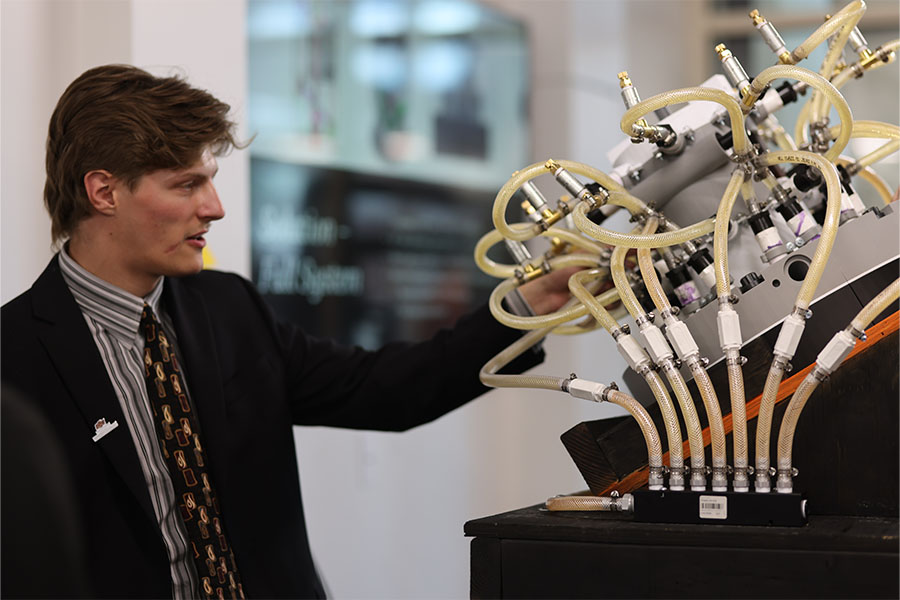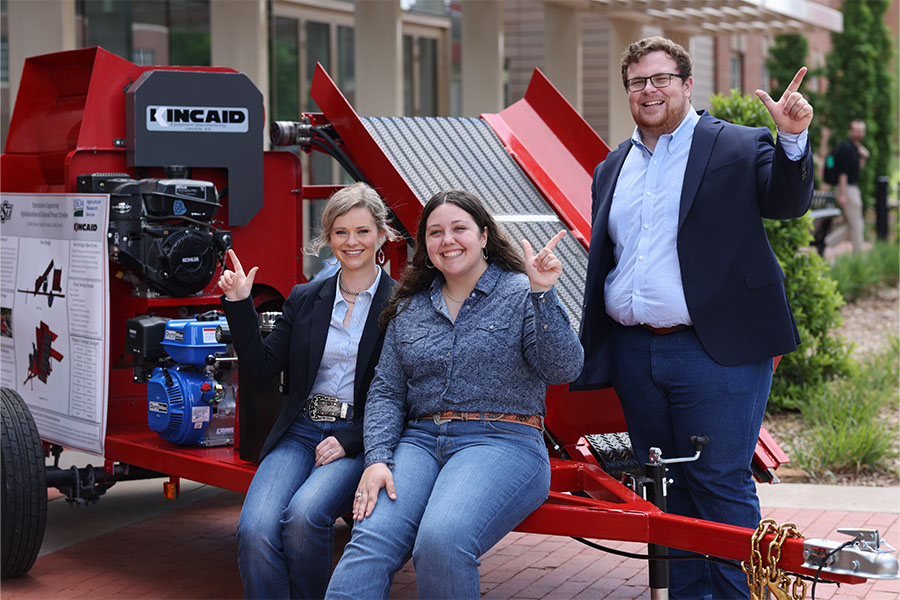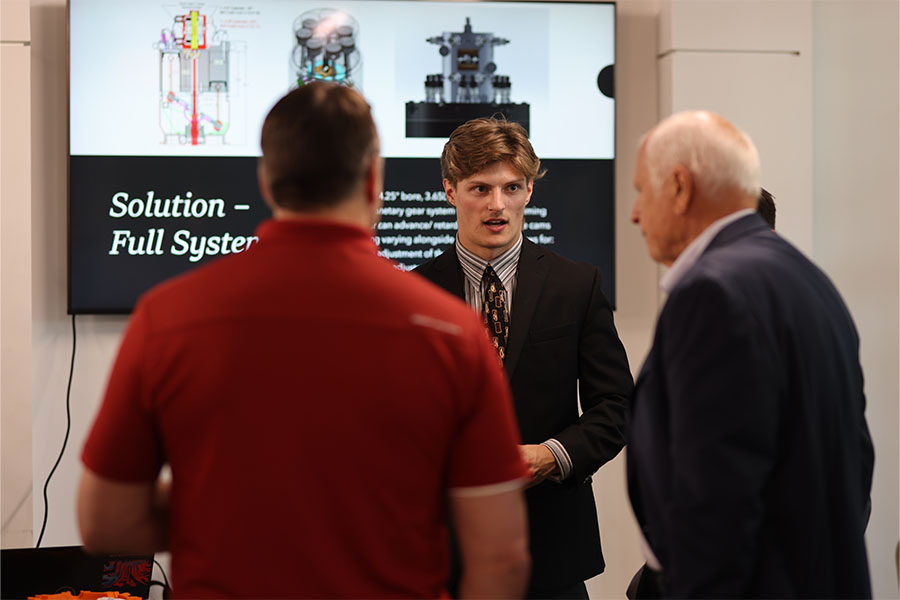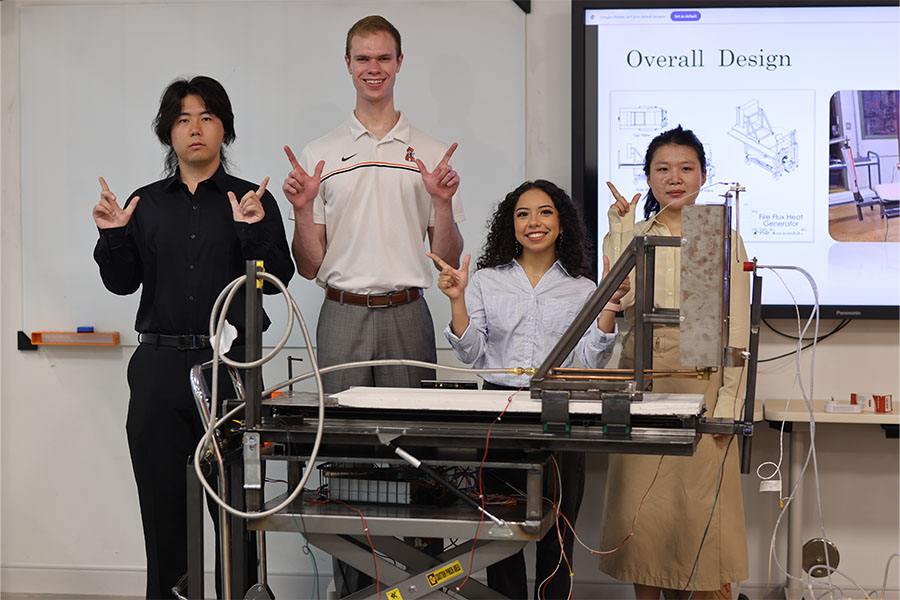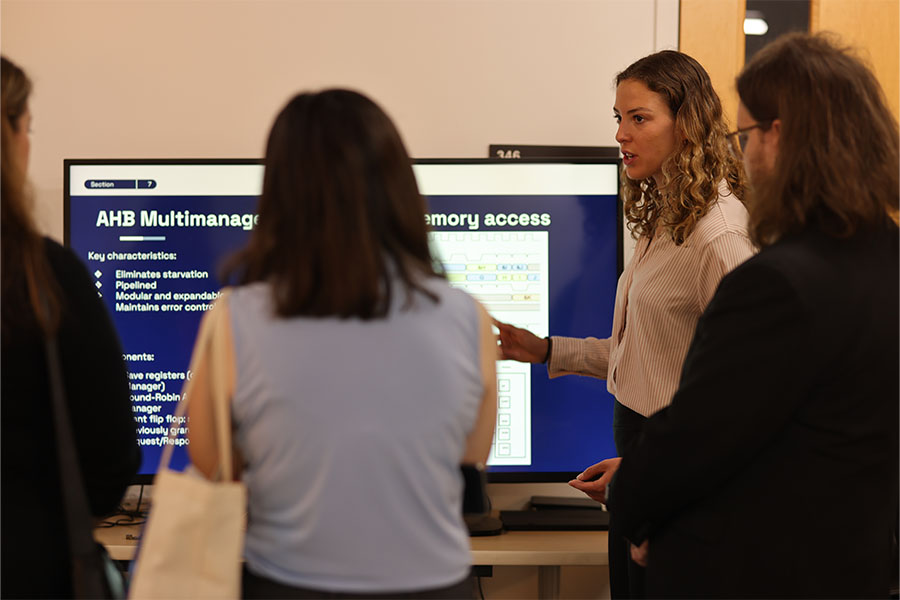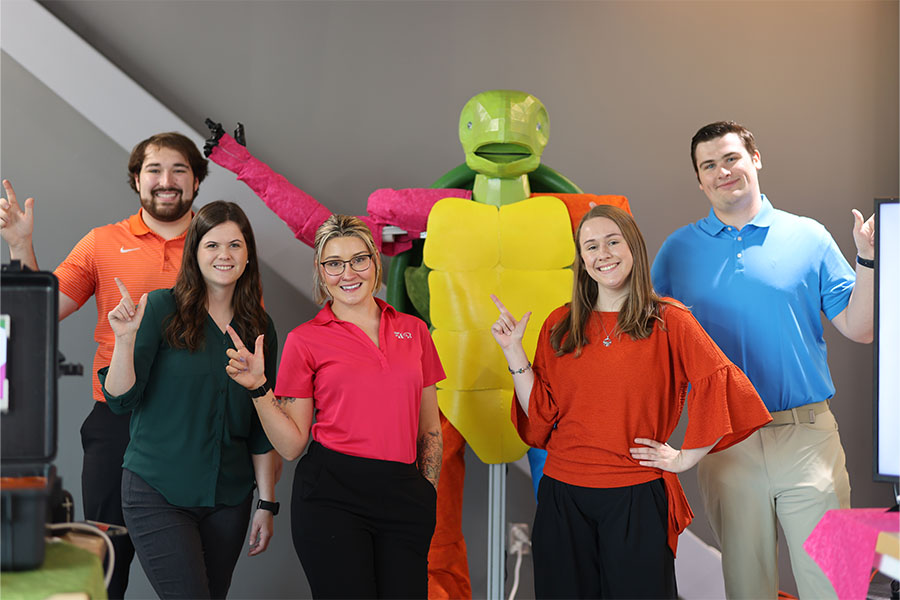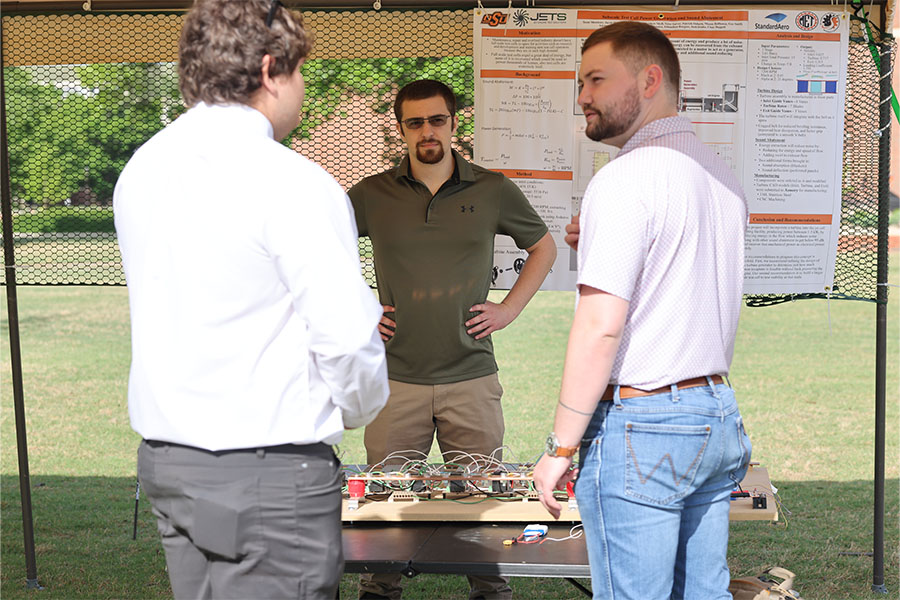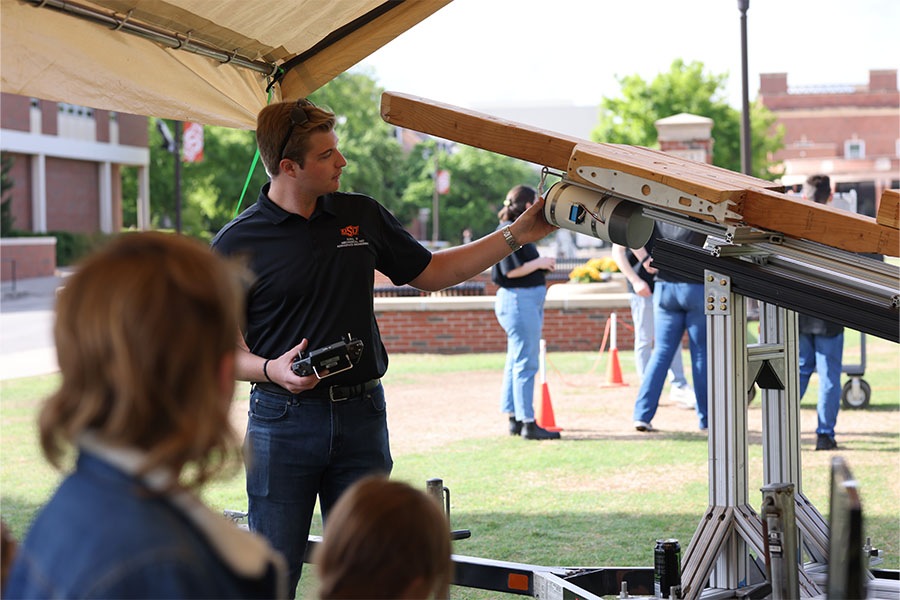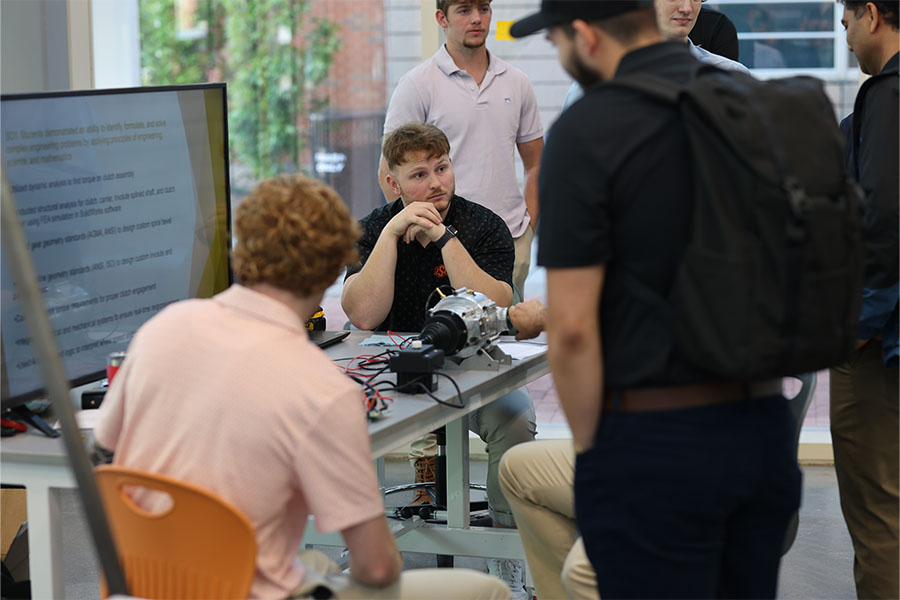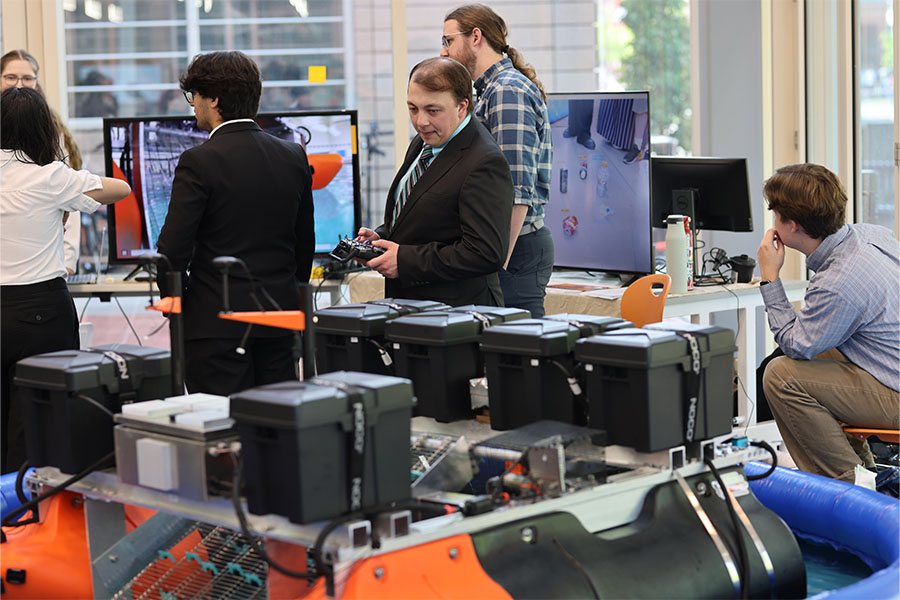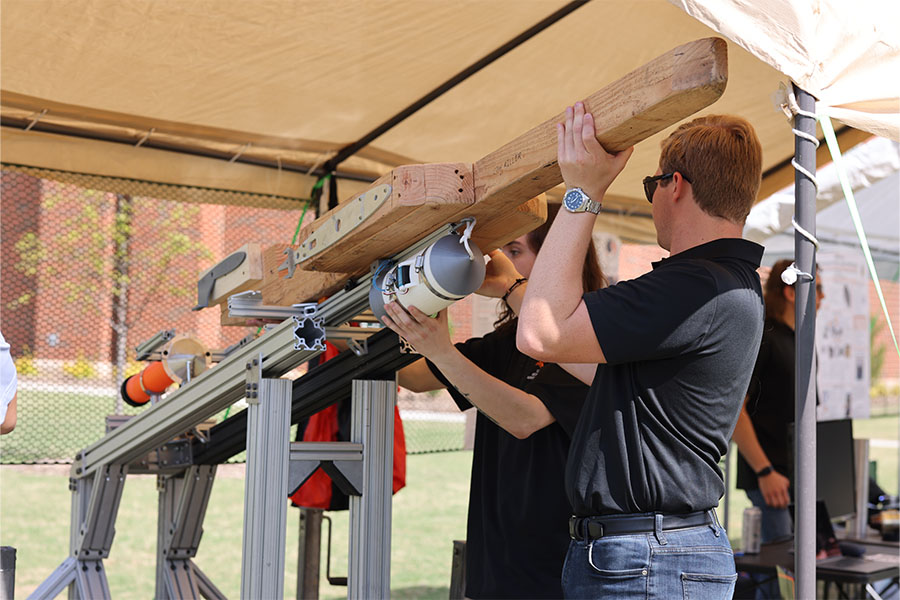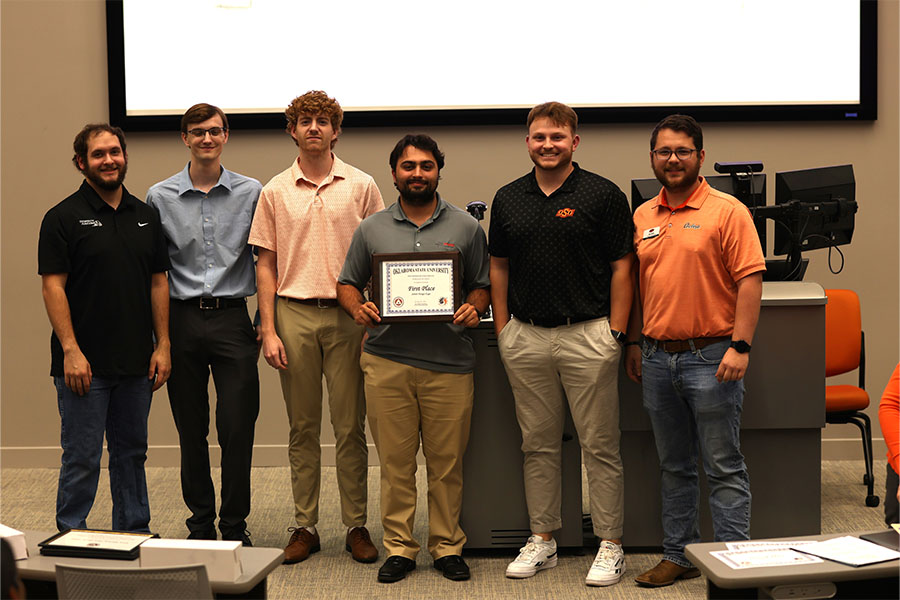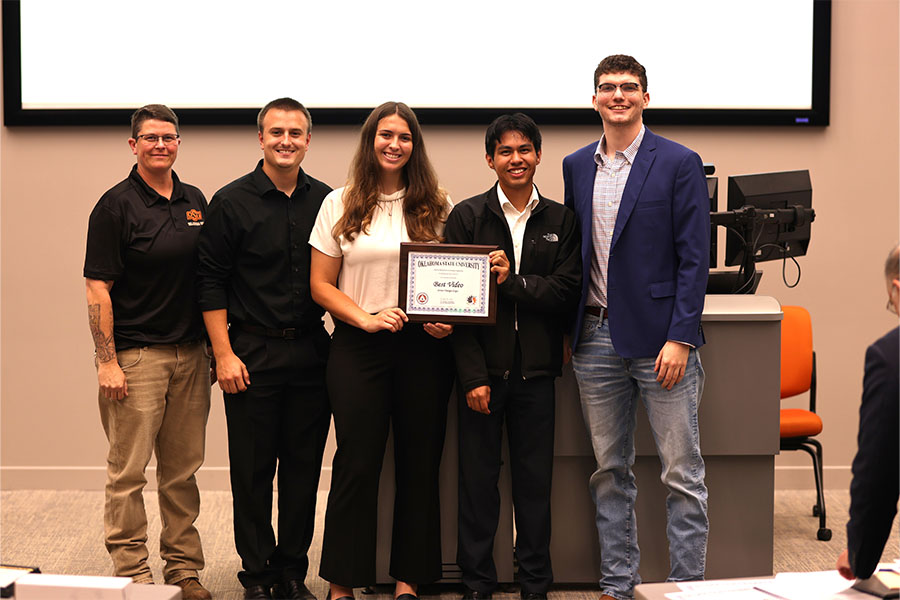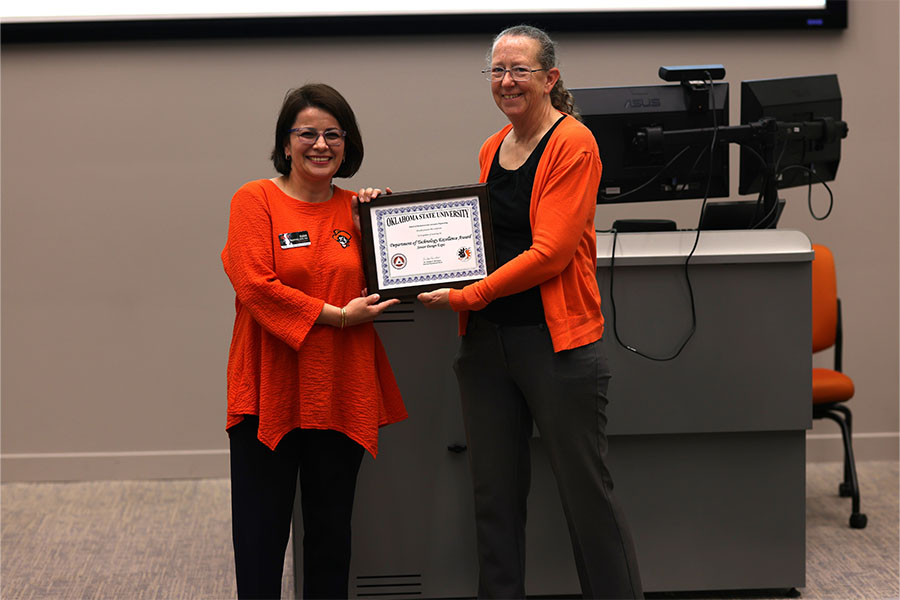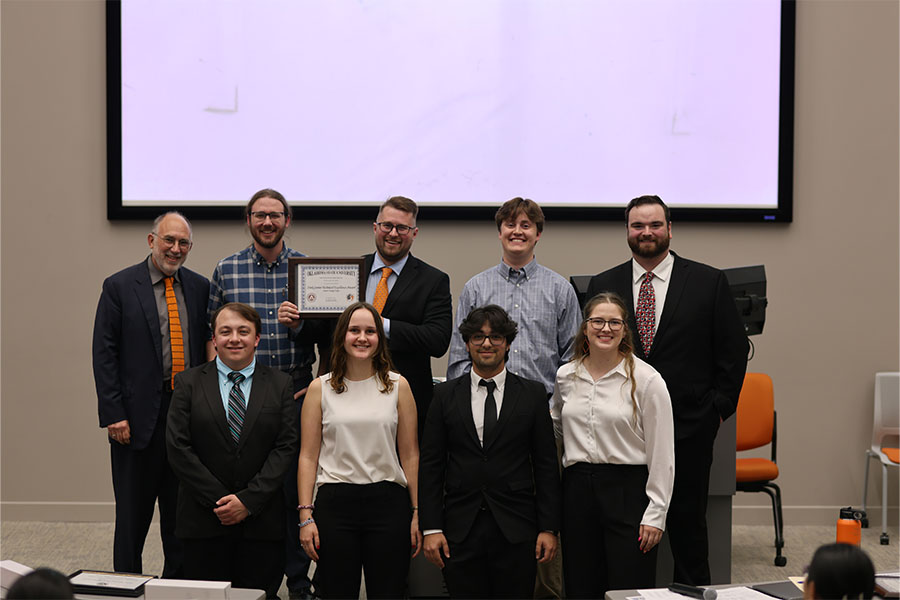CEAT holds spring 2025 Senior Design Expo
Tuesday, April 29, 2025
The College of Engineering, Architecture and Technology held its spring 2025 Senior
Design Expo on Friday, April 25 to showcase students’ research projects to peers,
alumni, industry leaders and faculty.
Held each fall and spring semester, the Senior Design Expo exemplifies CEAT’s emphasis
on effective pedagogy and vital experiences. The teams engage with industry, alumni
and faculty equipping them with advanced knowledge and exposure that prepares them
for real-world settings, creating professionals with strong technical knowledge, interdisciplinary
training and business acumen.
Altogether, 86 projects were displayed throughout ENDEAVOR and at OSU-Tulsa with hundreds
of people who visited throughout the day.
Following the Expo, awards were given to honor the top projects and the students'
hard work:
OSU-Tulsa
1st place team: Industrial Manufacturing Design Solutions - X-Ray Machine Positioner
Darrin Turner, Jorge Bernal, Clinton Palmer, Tim Debruyn, and Hau Sang,
Co-instructors: Dr. Jay Hanan and Laura Southard. Advisor: Dr. Masoud Allahkarami
WEBCO Kellyvile uses a 6000lb X-Ray machine to inspect their tube production lines. The X-ray machine is used to check the quality of orbital welds that join sections of coiled tubing together. The machine is currently moved on air casters, but an operator must manually move the machine into position. Production lines must be shut down during an inspection. The OSU-Tulsa student team generated and prototyped a design for a mostly automatic device that will service two production lines while having minimal impact on the shop floor. The device and the X-ray machine will fit between a pair of production lines where it will automatically rotate 90 degrees either direction and translate into position. The device eliminates the need for tedious manual movement by an operator and prevents production line disruptions. The machine also allows an operator to quickly and accurately make fine adjustments to align the X-Ray machine with the weld spot.
Best Video: Battery Electric Solar Trailer
Anthony Migyanka, Greg Shildt, Emmy Pummill, Ana Gonzalez, Grayson Campbell and Miguel
Vergara. Advisors: Dr. Hamid Nazari Pouya and Wendy Hall
The OSU Landscaping team uses electric tools and transports their equipment in a small
trailer. For this project, the team was tasked with designing and implementing a solar
system that would provide and store power for the equipment in that trailer. The team’s
design integrates a photovoltaic system, battery storage, a powerful inverter and
a friendly user interface to provide a reliable power source for the landscaping team’s
daily needs. In addition, the team was asked to demonstrate sun-tracking capabilities
with a small-scale design. This design will adjust a solar panel for maximum power
generation, following the sun or a UV lamp.
Video
Electrical and Computer Engineering
1st place team (tie): Autonomous Firefighting Vehicle
Brendan Bovenschen, Jesse Galloway, Landon Fox and Collin Bovenschen.
Advisors: Dr. Joe Conner, Dr. Shahriar Shahabuddin and Prof. Nate Lannan.
The Autonomous Firefighting Vehicle (AFV) is intended to be a fully autonomous vehicle
capable of pathing, locating and extinguishing a fire source without any human intervention.
The AFV’s place alongside other fire suppression methods is as a first responder,
allowing manned firefighting crews to arrive after the vehicle has begun extinguishing
the fire source. The AFV’s other intended usage is as a safety measure to protect
these manned operations, where sending in firefighters would be dangerous to their
health or safety. This protocol could be enacted if a landed airplane caught on fire,
potentially causing an explosion, letting the AFV complete its duty without fear of
human safety. This might also be deployable at the site of petroleum plants, where
escaped gases could prove toxic.
1st place team (tie): Q-TAG
Reid Wilson, Dylan Saltos, and Karsen Madole.
Advisors: Prof. Nate Lannan and Joel Quarnstrom.
We want to reinvent the traditional nametag. Our goal is to engineer a nametag that
will consist of an e-ink display, have a microphone for recording audio, have a camera
for taking snapshots, include a mobile application for interacting with the tag and
have at least a 40-hour battery life.
Electrical and Computer Engineering - Interdisciplinary
1st place: OKCubeSat
Mike Arledge, Logan Sharp, Brice Prince, Soren Petersen, Joshua Ingram and Trenton
Strawderman. Advisors: Dr. Imraan Faruque and Dr. John O’Hara.
The Oklahoma CubeSat Initiative is based at Oklahoma State University. The initiative’s mission is to design and develop a functional CubeSat that can determine the state of a tumbling, tethered object in low earth orbit and to measure debris flux of the orbit. This semester’s senior design project scope is to redevelop the CubeSat from prior design concepts to better suit the primary and secondary missions. This initiative’s vessel is a 3U CubeSat that maintains a single “U” of space for its payload. A “U” has standard dimensions of 10x10x10cm. This makes a CubeSat and its standards a robust and user-friendly form factor for space missions. The scope of work has been defined into two separate areas which indicated the need for two disciplines of engineering students. The mechanical engineering students are tasked with designing, developing, proving, fabricating and testing the new mission satisfactory payloads. They will work on orbit selection, atmospheric factors, deployable strategies, retraction strategies and material selection. Once defined, their scope pivots to the novelty of fabricating a prototype of their deployable structures. The electrical engineering students are tasked with developing a number of subsystems. Power budgeting is modeled over the course of the mission to determine the optimal method to create and store energy. The communication methods are examined to create a link budget to validate downlink capability of the orbit and data transmission speeds.
Biosystems and Agricultural Engineering
1st place: Chartech Innovations
Brody Bouher, Clara Buckmaster and Logan Morris. Advisor: Dr. Kevin Moore.
This senior design project entails making a larger-scale biochar reactor for the Department of Horticulture at Oklahoma State University. Our sponsor, Dr. Bruce Dunn, has a reactor that does not meet his production capacity needs. The project looks to double the amount of char produced on an hourly basis by focusing on the efficiency of the system. Our design looks to improve the ease of operability, associated maintenance and production optimization of a newly developed system. Prior to speaking with subject matter experts, research was done on general categories of batch and continuous reactors to decide what would best suit our sponsor’s needs. In speaking to experts, it was determined that the goal will be to design a process rather than a system. This will allow the team to prioritize operation optimization. Ultimately, our design reflects the compiled knowledge of these sources and the needs of the sponsor. Several evaluation criteria will be utilized to ensure our reactor reaches the design specifications needed for our sponsor. These evaluations include production capacity testing, efficiency evaluations, safety assessments, feedstock variability testing, heat retention analysis and usability testing. Our project will also have a standard operating procedure to ensure ease of operation. The total budget for the project is $6,500 including the cost of the kiln, all associated fabrication costs and testing.
Mechanical and Aerospace Engineering
3rd place: Contrast Training Rig
Gabe Klein, Jacob Kalberer and Abigail Cooper.
Advisors: Dr. Jerome Hausselle and Dr. Jason Miller.
While performing any type of weight training, there are two phases to a lift – the
eccentric and concentric phase. The concentric phase is where you are shortening your
muscles to move a load and the eccentric portion is where you lengthen your muscles
to move a load. For example, during a bicep curl, the concentric portion of the lift
would be where you are moving the weight upward and the eccentric portion of the lift
would be letting the weight down. One important note is that your muscles can handle
more load eccentrically than concentrically - contrast training seeks to exploit this
principle to provide a more optimal training stimulus. Current market solutions only
allow for a single repetition of the exercise with contrast stimulus before needing
to be set down and reset. Our Senior Design project implores us to design a system
that will provide this contrast training stimulus through repeated repetitions of
a lift.
2nd place: Bullet's Tow - Safety Tow Hitch
Mollie Burchel, Magnus McKee , Aaron Haskell and Ethan Berzas.
Advisors: Dr. Jahan Bayat, Prof. Laura Southard and Joel Quarnstrom
The Safety Tow Company has contracted OSU Senior Design students to design and optimize
a safety tow apparatus which prevents trailers from decoupling from the trailer hitch.
The project’s scale is to deliver a complete design to the Safety Tow company for
mass manufacturing before the senior design expo. This will include a 1-to-1 scale
constructed prototype. The goal for this semester is to develop a product that embodies
the purpose of the original Safety Tow device but implemented for use on a traditional
drop hitch. These hitches are some of the most used, least expensive, widely available
and their design has been unchanged for decades. The project aims to build a fully
functional device that meets the teams given design criteria by the end of the semester.
VideoVideo
1st place: Baja Active Front Differential
John Terzian, John Sturgill, John Musshafen, Sam Myers, Fawaz Alroumi, Megan Merrill,
Sam Jares, Johnah Rodgers and Ian Mason. Advisor: Ray Lucas
This project looks to develop front differential for 2024-2025 SAE Baja Car by providing
a locking differential that is lighter and fits within the confines of the current
frame. It cannot conflict with the suspension and drivetrain design. This will be
a prototype differential with the ability to shift between 4-wheel drive and open
and closed states as well as lock/unlock while vehicle is in motion. This helps with
the maneuverability dynamic event as well as overall acceleration in suspension/traction
dynamic event.
Division of Engineering Technology
1st place: Limited Area Sprinkler Systems (FPST)
Daniel Long, Bingheng Chen, Chuhan Huang, Junxuan Huang, Saud Alqahtani, Clay Ivey,
Randolph Pedroso, Michael Wang, Cooper Garden and Randall Pruitt.
Advisors: Dr. Haejun Park, Dr. Virginia Charter and Michael Wang.
The purpose of our experiment over Limited Area Sprinkler Systems is to compare performance
between a 20-minute rated fire door and a sprinkler head over a door frame. This experiment
was a code that was proposed to the NFPA 13 public input but did not get implemented
into the code. NFPA 101, Life Safety Code, in the chapter of existing low-rise apartment
buildings, allows the option to temporarily install a limited area sprinkler system.
A limited area sprinkler system consists of a sprinkler system in the corridor, and
every doorway leading into the corridor had the option to install a single sprinkler
over the doorway or install a 20-minute rated fire door. The hypothesis for the experiment
is that the sprinkler head above the door frame will keep the corridor at a tenable
temperature, more so than the 20-minute rated fire door. This experiment would be
a design, build, burn experiment-performing a live scale burn. The simple format for
the construction of the experiment will be a corridor with two dwelling units that
would be attached to the corridor. Both dwelling units will have a door leading into
the corridor. One of the doors will be a 20-minute rated door and the other will have
one sprinkler head above a solid core door. There will be an automatic sprinkler system
throughout the corridor for both experiments. Trained firefighters will enter one
of the dwelling units and ignite the fire in the sprinklered dwelling unit first.
The ignited fire will burn for 20 minutes, and extinguishment will start in the 20th
minute. The second burn will be in the non-sprinklered dwelling unit. Trained firefighters
will ignite the burn and the flame will burn for 20 minutes, then extinguishment will
occur. To collect data, thermocouples, heat flux gauges and cameras will be spaced
throughout the dwelling units and the corridor. After conducting the two burns, the
data will be compared and show the difference between the two dwelling units and the
temperature that would influence the tenability in the corridor. From this experiment,
we hope to prove that a fire sprinkler head should be the only option in the code
when installing a limited area sprinkler system.
Zink Center Technical Excellence Award
River Wrangler - Autonomous Trash Collection Boat
Jace Brownlee, Antonio Valencia, Sabrina Fairchild, Nicolas Jolin, Colin Rockholt,
Phillip Farris, Nina Parvin and Yosep Lazar.
Advisors: Dr. Aaron Alexander, Dr. Mark Krzmarzick and Dr. Weihua Sheng
In anticipation for the 2028 Olympics, a private group wants to sponsor OSU to design
and build an autonomous trash boat to clean up the Oklahoma River in Oklahoma City.
This semester we are finalizing the mechanical aspect of the boat, starting the integration
of autonomy and working on a proof-of-concept for a docking station. Our team has
the opportunity to lower the amount of trash in the main river and lower the need
for human interaction to clean up the surface of the river.
Zink Center Collaborative Innovation Award
Current Racing - FSAE Electric Vehicle
Angel Trujillo, Andre Washington, Dustin Jones, Jordan Kristopher Andrews, Andrew
Ratterman, Kellen Driever, Justin Rogers, John Muths, Jacob Riley, Aidan Hamm, Gabe
Saliba, Jason King, Layton Moore, Joshua Wendel, Nathan Drywater, Jacob Moehle, Daniel
Kinard, Marcial Nye, Alex Stitt, Clayton Carter and Kade Welcher.
Advisors: Dr. Daniel Fisher, Dr. Ying Zhang and Ray Lucas.
The primary objective of this project is to establish Oklahoma State University’s
competitive Formula SAE Electric (FSAE EV) team and lay a strong foundation for future
participation in the competition. This semester’s tasks include conducting extensive
research, conceptualizing, designing, fabricating and testing a fully functional FSAE
electric vehicle. The project involves integrating all necessary electrical systems
into an existing Bullet Racing chassis to streamline development while ensuring compliance
with FSAE EV regulations. Formula SAE is a global competition that tasks student teams
with designing, building and racing formulastyle vehicles. Within FSAE, the electric
class highlights the industry’s growing focus on sustainable transportation. This
team is comprised of 21 talented members, reflecting a multidisciplinary approach
for tackling the challenges of an electric race car. The team includes students majoring
in mechanical engineering, aerospace engineering, electrical and computer engineering,
electrical engineering technology and industrial engineering and management.
Spring 2025 Senior Design Expo program

